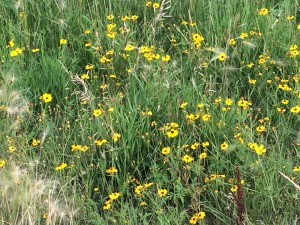A GARDEN FOR POLLINATORS
A GARDEN FOR POLLINATORS
Some plants are pollinated by wind, others by water and some are even self-pollinating. However, most flowering plants depend on bees, birds, flies, beetles, butterflies or other creatures to pollinate their flowers. In recent years pollinators have declined in numbers worldwide, due to destruction of their native habitats or have had their numbers reduced by pesticide use. We can help preserve and increase numbers of pollinators by creating safe, productive homes for them around our own homes, without pesticides and with less water.
The size of a pollinator garden can be based on the space available, but even a small plot or containerized garden can provide habitat for several species. Imitate the natural native landscape as a guide to the design of your garden. A sunny area with good drainage is best. To provide nesting places, leave or add logs, tree stumps, rocks, and piles of branches. Standing dead trees are excellent habitat for mason bees, woodpeckers and owls. A spot of bare soil will help certain pollinator species: for butterflies, provide a moist, muddy depression so they can drink and feed on minerals in the soil. A sprinkle of sea salt will provide even more minerals.
A garden planted with native plants is probably the best way to encourage all our pollinators. Double or “improved” flowers with no pollen or nectar are of no use to them and non-native plants are less likely to offer food for young. Since pollinators are present from early spring through late fall, try to plant a variety of plant types (shrubs, perennials and annuals) so you will have flowers all season. Plant in groups of several plants of each species, as you would see in nature. Planting a native wildflower mix will provide a good range of plant species and will provide color all season.
Bumblebees can tolerate cooler temperatures than other bees and appear early to feed on golden currant (Ribes aureum), service berries (Amelanchier alnifolia), and chokecherry (Prunus virginiana). Bumblebees nest in abandoned rodent burrows, under logs, rocks, or even under grass clippings. Most native bees prefer yellow, blue and purple flowers. Green sweat bees and leaf-cutter bees prefer aster-like flowers such as sunflowers, gaillardia and coneflowers. Orchard mason bees emerge early and are very efficient pollinators of fruit trees; native plants they prefer include penstemon, astragalus, chokecherry, and serviceberry.
Montana has 220 species of native butterflies. It is a good idea to provide both nectar-rich flowers and plants for their eggs and larvae. For example, the beautiful yellow and black two-tailed swallowtail butterfly lays its eggs on serviceberry leaves. Branches, leaf litter, bark and rocks provide winter cover for butterfly eggs, larvae, or pupae.
Moths are also excellent pollinators. You might have seen the striped sphinx moths appear around dusk to feed on evening primrose or honeysuckle. Some other Montana native insect pollinators are flower beetles, hover flies and pollen wasps. Pollen wasps have antennae with bulbs or “clubs” on the ends and do not bite humans; they live on pollen and make mud nests on twigs or rocks.
Hummingbirds are beautiful, tenacious creatures that transport pollen over long distances. Three species of hummingbirds (rufous, black-chinned and calliope) migrate to Montana every season. Hummingbirds prefer tubular-shaped flowers, such as native orange honeysuckle, monarda and penstemon, but will feed on many species that offer nectar.

